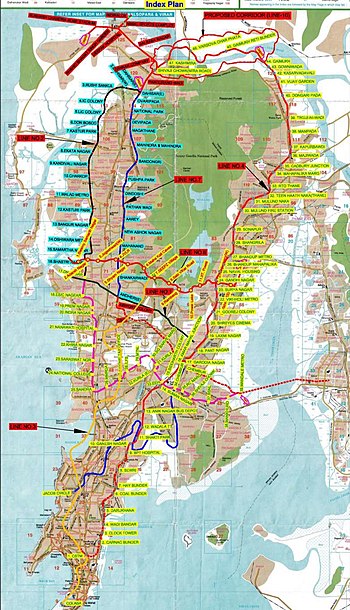Mumbai Metro
The Mumbai Metro is a new Mass Rapid Transit System (MRTS) envisaged to ease the burden on the older commuter rail network existng in Mumbai, India. The project is made up of three main phases; each phase involves the construction and operation of a separate metro railroad connecting different parts of suburban and downtown Mumbai which are not adequately served by current public transportation systems in the metropolis.
Phase One
As of 2007, only the first phase of the system has been planned. It is being built by Mumbai Metro One, a joint venture (called a Special Purpose Vehicle) between Reliance Energy Limited (REL), Veolia Transportation and the Mumbai Metropolitan Regional Development Authority (MMRDA). It involves the construction of an elevated railroad connecting Versova, a suburb in northwestern Mumbai to Ghatkopar in the east.
Layout
The entire length of the elevated railroad is 11.4 km, stretching from Versova on the western sea board of Mumbai to Ghatkopar, in the eastern suburbs. 12 elevated stations, constructed along and over major thoroughfares in the route will connect some of the most densely populated commercial, industrial and residential sections of suburban Mumbai.
Major stops along the route are (expected to be) at Versova, D. N. Nagar, Azad Nagar, Andheri, Western Express Highway, Chakala, Airport, Marol Naka, Saki Naka, Subhash Nagar, Asphala Road, and Ghatkopar.
Benefits
- The VAG (after the three main precincts through which the metro system is expected to pass through (Versova-Andheri-Ghatkopar)) section of the Mumbai Metro is the first direct rail connection within the city of Mumbai in the east-west direction.
- This system shall introduce rail based public transport access to several densely populated industrial precincts on the route (namely, MIDC and SEEPZ), which were previously serviced only by roads.
- Due to the use of elevated railroads, the system shall not disrupt commuting on any major thoroughfare in the affected precincts.
- The new elevated railroad claims to be able to provide additional comfort to passengers by way of fully air conditioned coaches, lifts and escalators and an automatic fare collection system.
- The typical waiting time for passengers is expected to be 180 seconds.
- It is claimed that the dedicated rail tracks on an elevated corridor shall considerably reduce the commuting time between far flung western suburbs (such as Versova) and eastern suburbs (such as Ghatkopar) to 21 minutes (instead of the earlier 90 minutes).
- Energy consumption is expected to reduce by 80% (per head) compared to commuting by road.
- As a medium capacity system, it will carry the equivalent of 7 lanes of bus and 24 lanes of car traffic in each direction.
Technology
- This is the first rail system in India to employ balastless tracks.
- The system shall use SCADA for regulating traffic flow, as well as fiber optic cables laid along the rail tracks for communications between the main control center and the stations and trains running between them.
- Automatic fare collection system at every station entry point.
- CCTV system at every station for continuous surveillance and monitoring.
Financial Model
This is the first public transport system being built with participation from both public entities such as the MMRDA and private corporations such as REL of India and Veolia of France. The financial model employed the first phase of the project is popularly called Build, Own, Operate and Transfer (BOOT); as the name suggest, the original partners in the project construct, take full ownership, operate (to generate revenues and profits) and then transfer the entire system to a government-run entity, to be eventually run as a public system.
The entire cost of the system (at 2006 prices) is expected to be US $ 565 million, which includes a 5% stake picked up by Veolia and a US $ 145 million funding by the federal government.
The fares have been fixed at 3 slabs: Rs. 6 (at 2004 prices) for journeys up to 3 kms., Rs. 8 for journeys up to 8 kms. and Rs. 10 for journeys beyond that distance. There is also a provision for government regulated fare revisions every four years to offset inflationary pressures.
